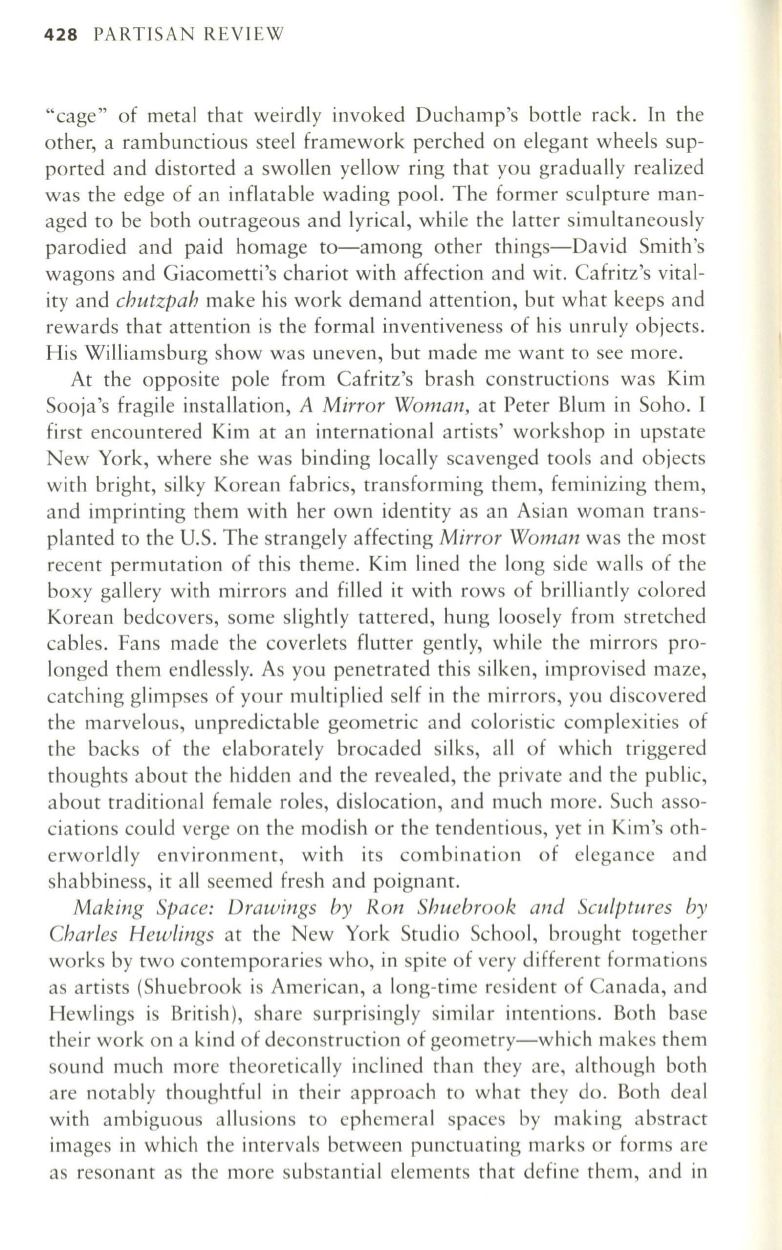
428
PARTISAN REVIEW
"cage" of metal that weirdly invoked Duchamp's bottle rack. In the
other, a rambunctious steel framework perched on elegant wheels sup–
ported and distorted a swollen yellow ring that you gradually realized
was the edge of an inflatable wading pool. The former sculpture man–
aged to be both outrageous and lyrical, while the latter simultaneously
parodied and paid homage to-among other things-David Smith's
wagons and Giacometti's chariot with affection and wit. Cafritz's vital–
ity and
chutzpah
make his work demand attention, but what keeps and
rewards that attention is the formal inventiveness of his unruly objects.
His Williamsburg show was uneven, but made me want to see more.
At the opposite pole from Cafritz's brash constructions was Kim
Sooja's fragile installation,
A Mirror Woman,
at Peter Blum in Soho. I
first encountered Kim at an international artists' workshop in upstate
New York, where she was binding locally scavenged tools and objects
with bright, silky Korean fabrics, transforming them, feminizing them,
and imprinting them with her own identity as an Asian woman trans–
planted to the U.S. The strangely affecting
Mirror Woman
was the most
recent permutation of this theme. Kim lined the long side walls of the
boxy gallery with mirrors and filled it with rows of brilliantly colored
Korean bedcovers, some slightly tattered, hung loosely from stretched
cables. Fans made the coverlets flutter gently, while the mirrors pro–
longed them endlessly. As you penetrated this silken, improvised maze,
catching glimpses of your multiplied self in the mirrors, you discovered
the marvelous, unpredictable geometric and coloristic complexities of
the backs of the elaborately brocaded silks, all of which triggered
thoughts about the hidden and the revealed, the private and the public,
about traditional female roles, dislocation, and much more. Such asso–
ciations could verge on the modish or the tendentious, yet in Kim's oth–
erworldly environment, with its combination of elegance and
shabbiness, it all seemed fresh and poignant.
Making Space: Drawings by Ron Shuebrook and Sculptures by
Charles Hewlings
at the New York Studio School, brought together
works by two contemporaries who, in spite of very different formations
as artists (Shuebrook is American, a long-time resident of Canada, and
Hewlings is British), share surprisingly similar intentions. Both base
their work on a kind of deconstruction of geometry-which makes them
sound much more theoretically inclined than they are, although both
are notably thoughtful in their approach to what they do. Both deal
with ambiguous allusions to ephemeral spaces by making abstract
images in which the intervals between punctuating marks or forms are
as resonant as the more substantial elements that define them, and in


